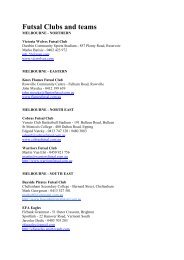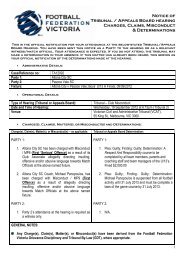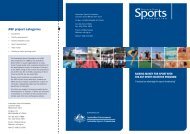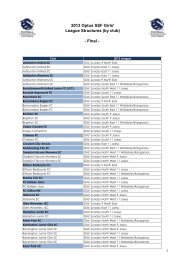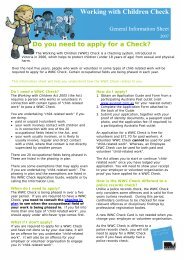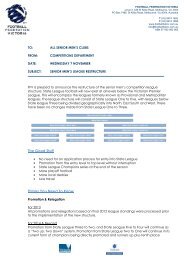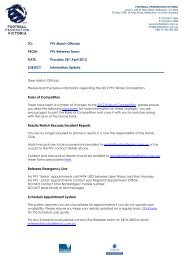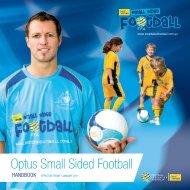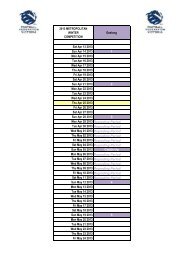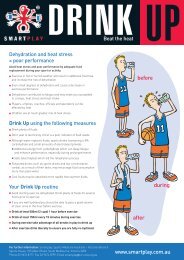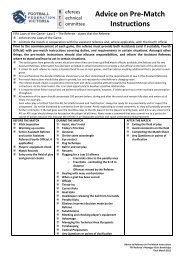PARTICIPANT MANUAL - Football Federation Victoria
PARTICIPANT MANUAL - Football Federation Victoria
PARTICIPANT MANUAL - Football Federation Victoria
You also want an ePaper? Increase the reach of your titles
YUMPU automatically turns print PDFs into web optimized ePapers that Google loves.
YOUTH<br />
FOOTBA L<br />
CERTIFICATE II<br />
<strong>PARTICIPANT</strong> <strong>MANUAL</strong><br />
COMMUNITY COACHING PATHWAY
YOUTH<br />
FOOTBA L<br />
CERTIFICATE II<br />
B | Youth <strong>Football</strong> CertificateI II Participant Manual
Contents<br />
Youth <strong>Football</strong> Certificate II Participant Manual | 1<br />
Introduction 2<br />
Overview of Coach Education 3 - 5<br />
What is T.I.C? 6<br />
Levels of the Community Coach Education Pathway 7<br />
How do the Certificate and Licence Differ? 8<br />
Furthering your Coach Education 8<br />
Method of Re-accreditation 8<br />
How do I become a Presenter and/or an Assessor? 9<br />
What qualification do I need to be able to present a course? 9<br />
How will the course be presented? 10<br />
Youth <strong>Football</strong> Certificate II Program 11 - 14<br />
How will I be assessed? 15<br />
Assessment Criteria Definitions 16<br />
Community Coach Education Program Session Plan 17<br />
Community Coach Education – Assessment Checklist 18<br />
Coach Self-Reflection Checklist 19<br />
Peer Observation Checklist 20<br />
Code of Ethics 21 - 22<br />
Youth <strong>Football</strong> Certificate II Practices 23<br />
Playing Out 24 - 26<br />
Positioning Games 27 - 29<br />
Attacking 30 - 32<br />
Defending 33 - 36<br />
Conditioning Practices 37<br />
Contacts 38<br />
Acknowledgements Back
2 | Youth <strong>Football</strong> CertificateI II Participant Manual<br />
Introduction<br />
Welcome to the Community Coach Education Program. Regardless of your playing and coaching background, <strong>Football</strong> <strong>Federation</strong> Australia has developed<br />
courses to suit all coaching levels and tailored them to ensure training is appropriate for the age of the players the coach is working with.<br />
You may have already downloaded the material which will help you through the course, and may also be used as your workbook.<br />
If you have not here is the link: www.footballaustralia.com.au<br />
The introductory course is the Grass Roots Certificate, which many of you would have completed already. If so you will now have a good idea of how to organise<br />
your training sessions using the three parts – Beginning, Middle and End. The terminology has been slightly changed on Junior, Youth and Senior levels to reflect<br />
the “piecing together” of age related training. They are called Warm Up, Main Part and Final Part - these will be explained in greater detail later.<br />
The main purpose of the Community Coach Education Program is to provide you with a range of “tools” to shape your coaching future and to help you plan<br />
and conduct suitable age appropriate training sessions. The community courses have been redesigned to be totally practical with a big emphasis on giving the<br />
participant coaching opportunities as well as continuous feedback by presenters and your peers throughout.<br />
You will also have the chance to be involved as if you were a young player by participating in the sessions (if you are physically able). The method of peer and<br />
presenter feedback is used to help you gain a greater knowledge of the strengths and weaknesses of your training methods. Your coaching knowledge and<br />
ability will improve as you gain more experience and attend further courses, read books and use the S2S online coaching tool.<br />
Norm Boardman<br />
National Coach Education Manager<br />
<strong>Football</strong> <strong>Federation</strong> Australia
FREE MEMBERSHIP TO S2S<br />
Overview of the FFA Coach Education Program<br />
There are now two distinct pathways for coaches within Australia - The Advanced Pathway and the Community Pathway.<br />
The Community Pathway<br />
gRAssROOTs<br />
FOOTBALL<br />
CERTIFICATE<br />
3 hour practical course<br />
JUNIOR<br />
FOOTBALL<br />
LICENCE<br />
14 hour practical course<br />
iNcluDiNG assessMeNt<br />
Youth <strong>Football</strong> Certificate II Participant Manual | 3<br />
Once you have enrolled and paid for your course you will be sent a campaign code for this exciting on line coaching resource. This will allow you FREE access<br />
until June 2011 enabling you to enjoy the many features of this tool. With over 1600 hundred practices broken down into age related training sessions and<br />
backed up by videos, you can download ready made sessions, create your own or even print off whole development programs. Please enjoy using this easy to<br />
use resource and good luck with your coaching.<br />
starting point<br />
for coaches of 6-7 yr olDs<br />
starting point<br />
for coaches of 8-11 yr olDs<br />
YOUTH<br />
FOOTBALL<br />
LICENCE<br />
20 MiN practical<br />
coachiNG assessMeNt<br />
YOUTH<br />
FOOTBALL<br />
CERTIFICATE II<br />
14 hour practical course<br />
YOUTH<br />
FOOTBALL<br />
CERTIFICATE I<br />
7 hour practical course<br />
starting point<br />
for coaches of 12-15 yr olDs<br />
sENIOR<br />
FOOTBALL<br />
LICENCE<br />
20 MiN practical<br />
coachiNG assessMeNt<br />
sENIOR<br />
FOOTBALL<br />
CERTIFICATE II<br />
14 hour practical course<br />
sENIOR<br />
FOOTBALL<br />
CERTIFICATE I<br />
7 hour practical course<br />
starting point<br />
for coaches of 16 yr olDs+
4 | Youth <strong>Football</strong> CertificateI II Participant Manual<br />
The Advanced Pathway<br />
LEvEL II<br />
FUTsAL<br />
LICENCE<br />
6 Day course<br />
LEvEL I<br />
FUTsAL<br />
LICENCE<br />
6 Day course<br />
pRO-dIpLOmA<br />
5 week course<br />
A LICENCE<br />
4 week course<br />
B LICENCE<br />
17 Day course<br />
+ asc iNterMeDiate<br />
GeNeral priNciples<br />
C LICENCE<br />
2 week course<br />
starting point<br />
LEvEL III<br />
gOALkEEpINg<br />
LICENCE<br />
6 Day course<br />
LEvEL II<br />
gOALkEEpINg<br />
LICENCE<br />
6 Day course<br />
LEvEL I<br />
gOALkEEpINg<br />
LICENCE<br />
6 Day course<br />
The Advanced Pathway, as the name implies, is for coaches who have a greater dedication to their coaching and who may eventually wish to coach at the<br />
professional level - hence the associated commitment which is necessary given the depths of content on those courses.<br />
The Community Pathway is aimed at coaches who while still dedicated, prefer to coach (primarily) at amateur level and who are much less ambitious<br />
about coaching at higher levels. These coaches, however, are still seeking assistance with the preparation, organisation and conduct of safe, age related<br />
training sessions.
Youth <strong>Football</strong> Certificate II Participant Manual | 5<br />
The exciting part about having two pathways is that there is now a course for all coaches at whatever level they choose. Furthermore, at the Community level,<br />
coaches can now choose where they wish to “enter” the pathway. For example, instead of the old method of having to attend the Junior Course followed by a<br />
Youth Course (gain an advanced pass), before enrolling on the Senior Course (vertical approach). Coaches can now enter at the level appropriate to the age<br />
group that they will be coaching (horizontal approach).<br />
The courses are tailored to suit the needs of “age related” training, matched up with the size of the field the players will be playing on and the technique/skills<br />
required at that age.<br />
For example at Grass Roots level age 6-7 (4 v 4) the National Curriculum focus is on “learning to master the ball” so the emphasis is on FUN, lots of ball<br />
touches, 1 v 1s and shooting.<br />
The next age is Junior (8-11 years old ) playing lots of football related games (7 v 7/ 9 v 9) at training is vital in terms of learning. At this level the development<br />
goals of the National Curriculum are “learning to act with the ball purposefully” and “ learning to play together (with team mates) purposefully”.<br />
Helping the players to make decisions based on football problems becomes more important as well as the ongoing development of their individual and collective<br />
technical ability through “game like” activities similar to those they may face in matches (i.e. combining with one another to beat an opponent). Another focus is<br />
for the coach to provide opportunities for the players to try different positions. Once again, a critical component at this age is the need for the players to have<br />
a “fun” experience and for the coach to nurture the young players’ love for the game through the provision of a positive learning environment.<br />
At Youth level (12 – 15 years old) studies have shown that players are starting to<br />
think about specializing in positions and here the development goals of the National<br />
Curriculum are“learning the positions” and“learning how the basic tasks link together”.<br />
It is important to note that increasing the development of technique linked into game<br />
awareness (decision making) and position specific coaching makes up the focus for this level.<br />
At the Senior level (16 years and above) the National Curriculum moves to reflect more<br />
“team” coaching through the development goals ‘Learning to play as a team’ and<br />
‘Performing / Winning as a team’ – at the same time emphasizing individual creativity,<br />
creative thinking and decision making, which are necessary ingredients to bring the<br />
“whole picture” together. Not withstanding the above, at every level, it is the coach’s<br />
responsibility to ensure that all players have an equal opportunity to develop and that<br />
the emphasis should always be on enjoyment and participation.
6 | Youth <strong>Football</strong> CertificateI II Participant Manual<br />
What is T.I.C.?<br />
T.I.C. is an acronym for –<br />
Technique –<br />
This is the foundation of all football ability and is best developed at a young age. Known as the “golden” years in Japan it is a critical time for the development<br />
of fundamental motor skills in youngsters. Development in primary school aged players is rapid in contrast to that in later years so emphasis on the development<br />
of technique in this period of growth is seen as essential. However, this does not mean that the coach disregards the need to address Technique throughout.<br />
Insight –<br />
Cognitive development in primary school aged players is varied and becomes more sophisticated with age and experience (exposure to thinking games).<br />
Ability to understand concepts will vary from player to player. Therefore Insight starts to become developed through the Junior Licence level as the player starts<br />
to understand more concepts through the coach continually putting the players in “match like” situations and getting the players to solve problems practically,<br />
therefore gaining valuable game-based experiences.<br />
Communication –<br />
The need to communicate becomes more important as the player grows older and develops an understanding of the needs within the game on a team basis –<br />
communication can be directly attributed to confidence and experience. Hence the greater emphasis on the C in the Senior level.<br />
T.I.C.s are the training and coaching objectives of the National Curriculum identifiable within each level according to the age group that is being coached.<br />
Getting a T.I.C. for football will help you focus on the most important part of the players’ development. In other words, if you look at the Development Goals<br />
together with the training and coaching objectives at each level and aim your training outcomes at those, you will not go far wrong. However, the three are<br />
not used in isolation and should always be considered together.<br />
Development Goals age Group tic<br />
Learning to master the ball U/6 – U/7 Getting a ‘TIC’ for football<br />
Learning to act with the ball purposefully U/8 – U/9 tiC<br />
Learning to play together purposefully U/10 – U/11 tiC<br />
Learning the positions and basic tasks in 11 v 11 U/12 – U/13 tiC<br />
Learning how the basic tasks link together U/14 – U/15 tiC<br />
Learning how to play as a team U/16 – U/17 tiC<br />
Performing/winning as a team U/18 – U/19 tiC
Levels of the Community Coach Education Pathway<br />
FFA Grassroots Certificate Course<br />
Youth <strong>Football</strong> Certificate II Participant Manual | 7<br />
This course provides the “novice” coach with the necessary “tools” to create a fun environment for the players, one in which they can learn to play with the ball,<br />
practise their basic movement patterns and develop a love for the game through good training and playing experiences. The course is held over three (3) hours<br />
and is usually carried out at club level with no cost to the participant.<br />
FFA Junior Licence Course<br />
This fourteen (14) hour course is designed to help those coaches who are training 8 – 11 year old players and will provide ideas on how to create a positive<br />
learning environment for the players. As the field sizes/number of players increase slightly so do the challenges for our youngsters, for example; passing,<br />
controlling the ball, movement and decision making. The coach at this level is encouraged to conduct meaningful training sessions that will help develop the<br />
players’ decision making processes so they can start to solve problems on the field without having to rely entirely on the coach.On this course the coaches are<br />
provided with helpful hints on using the questioning / challenging technique to assist their young players in decision making as well as some basic information<br />
regarding positional play so their players have an opportunity to play in different positions as they develop an understanding of the game’s requirements.<br />
FFA Youth and Senior Certificate 1 Courses<br />
Certificate One Courses are conducted over 7 hours. These courses provide opportunities for coaches to see model sessions by the Presenter and to get<br />
involved in the planning and presentation of safe, appropriate and age related practices. These courses are “non assessed” meaning that participants will not<br />
be required to do an assessment to be awarded the Certificate but rather will have ongoing opportunities throughout the course via a series of “group coaching”<br />
practise sessions. They will complete a “self assessment” checklist following their session and receive feedback from peers as well as the presenter.<br />
FFA Youth and Senior Certificate 2 Courses<br />
Certificate 2 courses are conducted over a 14 hour duration. They have a similar format to Certificate 1 courses and seek to reinforce the methodology of<br />
teaching through seeing and experiencing more “model” sessions as well as more opportunities to conduct practices as part of a group and as an individual in<br />
preparation for the Licence Assessment<br />
FFA Licence Assessments<br />
After attending Certificate 1 and 2 where you will be involved in planning , organising and conducting practices as well as seeing model sessions by the<br />
presenter, to gain a Licence you will be required to conduct a 15 minute practical session during which your competency to coach at the appropriate level<br />
will be assessed by a qualified assessor. This can be done at your local club or on an assessment day/night organised by your member federation, or as part<br />
of the course.
8 | Youth <strong>Football</strong> CertificateI II Participant Manual<br />
How do the Certificate and Licence Differ?<br />
The easiest way to define the distinction that is now being made is as follows:<br />
Certificate: Coaching competencies will be highlighted and experienced but not formally assessed at this stage.<br />
Licence: Coaches are formally assessed and deemed competent or not yet competent based on the criteria from the coaching checklist<br />
Naturally, a higher order of planning, thinking, observing and organisation would be expected should you wish to qualify for the licence accreditation. In either<br />
course you will have a number of opportunities on the course to develop your coaching.<br />
Furthering your Coach Education<br />
To build on your knowledge base and further your coach education your Member <strong>Federation</strong> and/or Region/Association will conduct regular updates. There will<br />
also be FFA seminars and workshops at regular intervals for you to attend should you wish. For more information go to www.footballaustralia.com.au or your<br />
Member <strong>Federation</strong> (contacts at rear of manual).<br />
Method of Re-accreditation<br />
Licence Level<br />
In order to be re-accredited, every four (4) years a coach will simply need to show that they can display the same competencies as they did when they first<br />
received their accreditation i.e. Can they plan a (safe) session, organise, use appropriate questioning, modify etc…This will be done as a practical demonstration<br />
(possibly with your own team) at a local club/association level to make it much easier and less time consuming for all concerned.<br />
Certificate 1 or 2 level<br />
Every Four (4) years a coach will need to attend and complete another community (certificate) course to remain accredited.
How do I become a Presenter and / or an Assessor<br />
Youth <strong>Football</strong> Certificate II Participant Manual | 9<br />
Should you wish to become a Presenter and / or an Assessor you must attend the State workshop conducted by your Member <strong>Federation</strong> annually, however<br />
should circumstances prevent your attendance you can be “mentored” in the process by attending and assisting on at least one course ( M.F.’s discretion)<br />
at the level at which you would like to present and/or assess. An application form is also available on the FFA website which should be processed through<br />
your Member <strong>Federation</strong>.<br />
What qualification do I need to be able to present a course?<br />
You need to have at least a licence for the level that you will be presenting. i.e. youth licence = present youth level<br />
presenter / assessor level type accreditation required to become a<br />
presenter or assessor<br />
Grassroots <strong>Football</strong> Certificate Presenter Grassroots <strong>Football</strong> Certificate<br />
Junior <strong>Football</strong> Licence Presenter/Assessor Junior <strong>Football</strong> Licence<br />
Youth <strong>Football</strong> Certificate I Presenter Youth <strong>Football</strong> Licence<br />
Youth <strong>Football</strong> Certificate II Presenter Youth <strong>Football</strong> Licence<br />
Youth <strong>Football</strong> Licence Assessor Youth <strong>Football</strong> Licence<br />
Senior <strong>Football</strong> Certificate I Presenter Senior <strong>Football</strong> Licence<br />
Senior <strong>Football</strong> Certificate II Presenter Senior <strong>Football</strong> Licence<br />
Senior <strong>Football</strong> Licence Assessor Senior <strong>Football</strong> Licence
10 | Youth <strong>Football</strong> CertificateI II Participant Manual<br />
How will the course be presented?<br />
Model Sessions<br />
At the start of each module the presenter will conduct “model” sessions featuring three components – Warm Up, Main Part and Final Part.<br />
Warm Up<br />
As the name indicates, the warm-up is the methodology aimed at increasing the blood flow, gradually raising the body temperature and preparing the muscles<br />
for work. This is done using a combination of ball work combined with dynamic stretching, sometimes it may be done without the ball but it is always “dynamic”.<br />
Main Part<br />
Once the “theme” for the session has been established i.e. Passing / Striking etc… the main part is used to practise the technique using a small sided game<br />
or a functional practice to provide the players with repeated opportunities to develop the particular technique / skill. During this part the presenter will show<br />
how to coach at the community level using demonstrations of good “models” or demonstrating themselves and showing examples of how to encourage and<br />
praise the players.<br />
Final Part<br />
In the final part of the session the presenter will sometimes show<br />
how it is all put together usually based on the practise, and dealing<br />
with the players in a “match like“ scenario featuring their actual<br />
positions and formations relevant to the curriculum.
Youth <strong>Football</strong> Certificate II Program<br />
DAY 1 MORNING / NIGHT 1 (210 minutes)<br />
Presenter conducts two (2) model sessions (120 minutes):<br />
1. Playing out<br />
2. Positioning Games<br />
Model sessions to feature:<br />
• Warm-Up<br />
• Main Part<br />
• Final Part<br />
BREAK (20 minutes) Hand out topics as below for group work<br />
Group Work (60 minutes)<br />
Candidates are split into four (4) groups of four (4).<br />
Each group will be given the following tasks:<br />
• Group 1/Group 3 = Playing Out<br />
• Group 2/Group 4 = Positioning Games<br />
• All members A,B,C,D of each group will plan their session.<br />
• C and D will set up and organise the practice.<br />
• A will start the session and make one modification (Based on observation.)<br />
• B will make a further modification (Based on observation.)<br />
• Each practice will be approximately 15 minutes (Incl. feedback.)<br />
Youth <strong>Football</strong> Certificate II Participant Manual | 11<br />
• At the conclusion of each group practice all candidates will be invited to provide feedback in a “controlled” discussion facilitated by the presenter –<br />
NO MORE THAN TWO (2) MINUTES – while the next group is setting up.<br />
REVIEW (10 minutes)
12 | Youth <strong>Football</strong> CertificateI II Participant Manual<br />
Day 1: Afternoon / Night 2 (210 minutes)<br />
presenter conducts two (2) model sessions (120 minutes)<br />
1. Attacking<br />
2. Defending<br />
To feature:<br />
• Warm-Up<br />
• Main Part<br />
• Final Part<br />
BREAK (20 minutes) and Organisation of group work within break<br />
Group Work (60 minutes)<br />
Candidates are split into four (4) groups of four.<br />
Each group will be given the following tasks:<br />
• Group 1/Group 3 = Attacking Play<br />
• Group 2/Group 4 = Defending<br />
• All members A,B,C,D of each group will plan their session.<br />
• A and B will set up and organise the practice.<br />
• C will start the session and make one modification (Based on observation.)<br />
• D will make a further modification (Based on observation.)<br />
• Each practice will be approximately 15 minutes IN TOTAL i.e. Two (2) candidates (Incl. feedback.)<br />
• At the conclusion of each group practice all candidates will be invited to provide feedback in a “controlled” discussion facilitated by the presenter –<br />
NO MORE THAN TWO (2) MINUTES – while the next group is setting up.<br />
REVIEW AND HAND OUT TOPICS (10 minutes)<br />
• Split the candidates into eight (8) groups of two (2)<br />
• Pairs and individuals (Candidates will conduct sessions in pairs then on their own)<br />
• HAND OUT TOPICS (Playing out etc….) two groups will have the same topic i.e. Groups 1 and 5 will have Playing Out.<br />
• This time as there are only two members of the group:<br />
• (A) will start the session and make one modification (Based on observation.)<br />
• (B) will make a further modification (Based on observation.)<br />
• Each practice will be approximately 15 minutes in total (incl. feedback) At the conclusion of each group practice all candidates will be invited to provide<br />
feedback in a “controlled” discussion facilitated by the presenter – NO MORE THAN TWO (2) MINUTES – while the next group is setting up.
DAY 2 MORNING / NIGHT 3 (210 minutes)<br />
GROUP WORK PRACTICES (120 minutes)<br />
Eight (8) groups of two<br />
• 10 minute practice per group (modifications based on observation)<br />
• Self reflection + 2 min discussion with presenter<br />
• Total = maximum 15 minutes per group<br />
BREAK (20 minutes)<br />
INDIVIDUAL WORK (60 minutes)<br />
USING THE SAME TOPIC AS THEY HAD WHEN THEY WERE IN PAIRS<br />
• 15 minute practice per individual. (Modifications based on observation.)<br />
• Conduct four (4) individual sessions + feedback from presenter<br />
REVIEW (10 minutes)<br />
Youth <strong>Football</strong> Certificate II Participant Manual | 13
14 | Youth <strong>Football</strong> CertificateI II Participant Manual<br />
DAY 2 AFTERNOON / NIGHT 4 (210 minutes)<br />
INDIVIDUAL WORK (90 minutes)<br />
• 15 minute practice per individual (Modifications based on observation.)<br />
• Conduct six (6) individual sessions + feedback from presenter.<br />
BREAK (20 minutes)<br />
INDIVIDUAL WORK (90 minutes)<br />
• 15 minute practice per individual (Modifications based on observation.)<br />
• Conduct six (6) individual sessions + feedback from presenter.<br />
COURSE CONCLUSION AND REVIEW (10 minutes)
How will I be Assessed?<br />
Checklists<br />
In this manual you will find five (5) forms :<br />
• The first shows you definitions of the Assessment Criteria used by the assessor.<br />
Youth <strong>Football</strong> Certificate II Participant Manual | 15<br />
• The second is a Session Planning form which is to be completed and given to the presenter prior to your practices sessions.<br />
• The third is the Assessment Checklist. This shows the criteria against which you will be assessed, this is used by the assessor.<br />
• The next is a Self Reflection Checklist which you will be asked to fill out following<br />
one or more of your sessions. This will help you to better understand which<br />
areas need more attention and which are already well developed in your practices.<br />
• The final one is a Peer observation form which you may be asked to complete<br />
to provide some feedback for others in the group.<br />
• You will need to print off three (3) copies of each of the above documents<br />
and bring them with you to the course.<br />
• You will also need to print, read, and bring the code of ethics agreement<br />
to the course and hand it in to the presenter.<br />
This paperwork will help you in your development as a coach.<br />
In the future you could have someone watch your sessions and<br />
provide feedback via any of these methods.
16 | Youth <strong>Football</strong> CertificateI II Participant Manual<br />
Assessment Criteria Definitions<br />
1. Does it look<br />
like football?<br />
2. players are engaged in<br />
an activity/game within two<br />
minutes?<br />
3. Games/activities are<br />
conducted in a safe<br />
coaching environment<br />
4. the coach used<br />
demonstrations to reinforce<br />
topic in a positive manner.<br />
5. the coach modified the<br />
session when necessary<br />
to challenge the players<br />
or to help them achieve a<br />
desired outcome?<br />
6. the players respond<br />
to the coach in a positive<br />
manner<br />
Game based decisions are being made and the activity has:<br />
• Area<br />
• Rules<br />
• Objective (target/goal)<br />
• Opposition<br />
Coach organises equipment<br />
• Balls/Markers/Bibs etc. in correct places<br />
• Communicates for group management purposes<br />
• Gives clear instructions to ensure players understand what to do<br />
Area was inspected<br />
• Games/activities are conducted away from fences<br />
• Games/activities reduce possible collisions etc.<br />
Comments are provided in positive language<br />
Key points are identified and reinforced with players<br />
Games/activities are modified using “CHANGE IT” methodology based on:<br />
• Players are not successful in achieving objective and motivation is waning<br />
• Players are too successful and are becoming uninterested<br />
• Games/activities are one sided<br />
Activity levels are high<br />
Players are trying to achieve session objective
Community Coach Education Program<br />
Session plan<br />
Topic (Session focus)<br />
Name<br />
Organisation details:<br />
Balls:<br />
Bibs:<br />
Markers:<br />
Players:<br />
Game instructions/demonstration:<br />
Diagrams:<br />
Youth <strong>Football</strong> Certificate II Participant Manual | 17
18 | Youth <strong>Football</strong> CertificateI II Participant Manual<br />
Community Coach Education –<br />
Assessment Checklist<br />
Name of candidate: Date:<br />
competence /<br />
performance criteria<br />
1. Was it an activity that looked like<br />
football? i.e. Game based decisions<br />
were being made and the activity<br />
had: Area Rules / Objective (target/<br />
goal) Opposition<br />
2. Were the players engaged in an<br />
activity/game within two (2) minutes?<br />
Transitions were made from one<br />
activity to the next (or modifications)<br />
within two (2) minutes.<br />
3. Were the games/activities<br />
conducted in a safe coaching<br />
environment.<br />
4. Communication skills ? Were<br />
the demonstrations clear,<br />
communicated positively and<br />
appropriately? i.e. Good “models.”<br />
Good use of Q and A.<br />
5. The coach modified the session<br />
when necessary to challenge the<br />
players or help them achieve a<br />
desired outcome<br />
6. The players responded in a positive<br />
manner i.e. actively involved.<br />
y N comments
Coach Self-Reflection Checklist<br />
Name of candidate: Date:<br />
Did you successfully deliver the following?<br />
session criteria<br />
An activity that looked like football.<br />
Game based decisions were being<br />
made and the activity had:<br />
Area<br />
Rules<br />
Objective (target/goal)<br />
Opposition<br />
Players were engaged in an activity/<br />
game within two minutes.<br />
Transitions were made from one<br />
activity to the next (or modifications)<br />
within two (2) minutes.<br />
Games/activities were conducted in<br />
a safe coaching environment.<br />
Demonstrations were used to reinforce<br />
topic in a positive manner.<br />
The session was modified when<br />
necessary to challenge the players or to<br />
help them achieve a desired outcome.<br />
Players responded in a positive manner.<br />
what did you notice when<br />
conducting the activity/game?<br />
Youth <strong>Football</strong> Certificate II Participant Manual | 19<br />
what would you do differently<br />
next time?
20 | Youth <strong>Football</strong> CertificateI II Participant Manual<br />
Peer Observation Checklist<br />
Observe the nominated coach and provide feedback as to the level of criteria observed. Some discussion or suggestions may be made as to how you may<br />
change the session.<br />
Did the coach deliver the following?<br />
session criteria yes /No comments<br />
An activity that looked like football.<br />
Game based decisions were being made<br />
and the activity had:<br />
Area<br />
Rules<br />
Objective (target/goal)<br />
Opposition<br />
Players were engaged in an activity/game<br />
within two (2) minutes.<br />
Transitions were made from one<br />
activity to the next (or modifications) within<br />
two (2) minutes.<br />
Games/activities were conducted in<br />
a safe coaching environment.<br />
Demonstrations were used to reinforce<br />
topic in a positive manner.<br />
The session was modified when necessary<br />
to challenge the players or to help them<br />
achieve a desired outcome.<br />
Players responded in a positive manner.
Coach’s Code of Ethics Agreement Form<br />
PLEASE COMPLETE ALL FIELDS - PRINT CLEARLY<br />
Title First Name Surname<br />
FFA Accreditation Level<br />
Mailing Address<br />
State P/C<br />
Phone Number: H W M<br />
Email Fax<br />
Country of Birth Date of Birth<br />
I agree to the following terms:<br />
1. I agree to abide by <strong>Football</strong> <strong>Federation</strong> Australia’s Code of Ethics overleaf.<br />
2. I acknowledge that <strong>Football</strong> <strong>Federation</strong> Australia may take disciplinary action against me, if I breach the code of ethics.<br />
Youth <strong>Football</strong> Certificate II Participant Manual | 21<br />
3. I understand that <strong>Football</strong> <strong>Federation</strong> Australia is required to implement a complaint handling procedure in accordance with the principles of natural justice,<br />
in the event of an allegation against me.<br />
4. I acknowledge that disciplinary action against me may include de-registration from <strong>Football</strong> <strong>Federation</strong> Australia ‘s Coach Licence Registration and the<br />
National Coaching Accreditation Scheme.<br />
Please refer to the Harassment free Sport Guidelines available from the Australian Sports Commission Website (http://www.ausport.gov.au/ethics/memprot.asp).<br />
I have read the <strong>Football</strong> <strong>Federation</strong> Australia Coaches’ Code of Ethics and agree to comply with its directives.<br />
Signature Date<br />
Signature of Parent/Guardian (if under 18)
22 | Youth <strong>Football</strong> CertificateI II Participant Manual<br />
Coach’s Code of Ethics<br />
✔ I will respect the rights, dignity and worth of all players and ensure that everyone is<br />
treated equally.<br />
✔ I will ensure that the players are involved in a positive environment, and that the<br />
game and training is a positive and enjoyable experience.<br />
✔ I will respect all players’ individuality and help them reach their own full potential.<br />
✔ I will be fair, considerate and honest with all players.<br />
✔ I will be professional and accept responsibility for my actions and encourage players<br />
to demonstrate the same qualities.<br />
✔ I will make a commitment to my team, and myself, that I will continue to improve<br />
my own knowledge of the game through coach education and various training<br />
programs. I will coach my players to play within the rules and in the spirit of the<br />
game of Soccer (<strong>Football</strong>).<br />
✔ I will avoid any physical contact with the players and should it be required it would<br />
be appropriate to the situation and necessary for the player’s skill development.<br />
✔ I will refrain from any form of personal abuse towards my players. Also I will be<br />
aware of any forms of abuse directed towards my players from other sources while<br />
they are in my care.<br />
✔ I will refrain from any form of harassment towards my players.<br />
✔ I will provide a safe environment for training and competition, by ensuring the<br />
equipment and facilities meet safety standards.<br />
✔ I will show concern and caution towards sick and injured players and allow for<br />
further participation in training and competition only when appropriate.<br />
✔ I will not engage in the use of crude, foul or abusive language that may be<br />
determined offensive or engage in any conduct detrimental to the image of the<br />
game when on or off the field.<br />
✔ I will refrain from arguing with the referee and / or assistant referees regarding<br />
decisions they make.<br />
✔ I will treat participants, officials and spectators with courtesy and respect.<br />
This code is designed:<br />
• To emphasise the elements of<br />
enjoyment and satisfaction to junior<br />
players and coaches involved in<br />
Soccer (<strong>Football</strong>).<br />
• To make adults including parents<br />
and coaches aware that young<br />
players play Soccer (<strong>Football</strong>)<br />
to satisfy themselves and not<br />
necessarily to satisfy adults or<br />
members of their own peer group.<br />
• To improve the overall health and<br />
fitness of Australia’s youth by<br />
encouraging participation in Soccer<br />
(<strong>Football</strong>) and making it attractive,<br />
safe and enjoyable for all to play.<br />
• To remind administrators, coaches,<br />
referees and parents that Soccer<br />
(<strong>Football</strong>) must be administered,<br />
taught and provided, for the good of<br />
those young people who wish to play<br />
Soccer (<strong>Football</strong>), as ultimately it is<br />
“their game”.
Youth <strong>Football</strong> Certificate II Practices<br />
Key<br />
Unbroken Line = Balls path<br />
Broken Line = Players’ run without the ball<br />
Unbroken line together = player dribbling the ball<br />
with Broken line<br />
Youth <strong>Football</strong> Certificate II Participant Manual | 23
24 | Youth <strong>Football</strong> CertificateI II Participant Manual<br />
Warm-Up: Playing Out<br />
Organisation<br />
• In a square 25m x 25m place two players as shown with a ball diagonally opposite each other.<br />
• In each of the other corners place one player and in the middle are two more.<br />
Rules / Instructions<br />
• The practice starts when the players with the ball pass their ball into the centre player who then passes on “anti clockwise” to the next corner.<br />
• All players must follow their pass and as they do they carry out dynamic stretches as demonstrated by the coach.<br />
Notes
Main Part: Playing Out<br />
A<br />
Organisation<br />
• 40m x 20m<br />
• Place a 5m goal at either end<br />
Rules / Instructions<br />
Youth <strong>Football</strong> Certificate II Participant Manual | 25<br />
• The game starts with 2 v 1… the objective being that the two try to get out of their half with one in possession of the ball and /or by passing the ball<br />
to their team mate in the other half then supporting.<br />
• They then try to score past the ‘keeper.<br />
• The player who goes to support in the other half drops out to the side then returns behind their goal and allows the “resting” player to come in (to goals).<br />
• The game starts with the other team having a 2 v 1.<br />
Notes<br />
C<br />
A<br />
C<br />
D<br />
B<br />
D<br />
B<br />
20<br />
40
26 | Youth <strong>Football</strong> CertificateI II Participant Manual<br />
Final Part: Playing Out in 1-4-3-3 game training<br />
Objective:<br />
• Playing out with a goalkeeper to create a “one man more” situation in the<br />
attacking half<br />
• Using a goalkeeper, two centre backs and one midfielder v two strikers<br />
Organization:<br />
• Two equal halves (40m x 40m) separated by a middle line<br />
• 10 outfield players and 2 Goalkeepers as shown<br />
Development of the exercise part 1:<br />
• Three blue defenders plus their GK play out against two (2) opponents.<br />
The blue defenders are trying to get one of their players into the opposing<br />
half to support the attacking two blue players who are marked by two<br />
yellow defenders. The third yellow defender is waiting behind the goals<br />
and comes to join the game once the attack has been completed.<br />
• The third yellow defender joins in whilst the attacking blue player who<br />
supported from the other half goes off and moves around behind their<br />
own goals.<br />
Development of the exercise part 2:<br />
• One of the defenders can cross the middle line running with the ball as<br />
shown OR by being part of a “third man running” combination play. i.e.<br />
wall pass/through pass etc…<br />
Methodical Development:<br />
• Free Touches later restricted to two or three<br />
• Scoring within ???? seconds / Smaller Pitch/ Offside
Warm-Up Positioning Games – 1-4-3-3 Game Training<br />
Organisation<br />
• 20m x 45m<br />
• As above each of the thirds will be 20m x 15m<br />
Rules / Instructions<br />
Youth <strong>Football</strong> Certificate II Participant Manual | 27<br />
• 6 (yellow) players try to keep possession of the ball from 2 (blue)“defenders” for a set time (i.e. 30 seconds) after which the two “defenders return to join<br />
their four team mates and play against 2 blue “defenders” after all players have had a turn count up the number of passes that were made…who is the<br />
winning team?<br />
• Ask the four (4) players to perform some dynamic stretching as they jog around passing the ball between each other in the area in which they are “resting”<br />
as part of the four.
28 | Youth <strong>Football</strong> CertificateI II Participant Manual<br />
Main Part: Positioning Games – 4 v 2<br />
Organisation<br />
• In an area of 15m x 15m<br />
• 6 players (3 groups of 2) play a “possession” game using 4 v 2.<br />
Rules / Instructions<br />
• Give a point for every ??? consecutive pass that the “4” make, alternately give the “defenders” two points for every successful interception, who can reach<br />
10 points first?<br />
• Rotate the teams regularly even if they do not reach their targets.<br />
Notes
Final Part: Positioning Games<br />
Organisation<br />
• 30m x 30m square<br />
• 6 v 6 (4 v 4 inside with two support players for each team on the outside)<br />
Game Development<br />
• 4 v 4 in the central area, team in possession tries to keep possession.<br />
• Set a certain number of passes to score a point.<br />
• Rotate the players on the outsides by allowing them to interchange with the person who passed the ball.<br />
• Give extra points if the player receiving the ball can do so without having to turn “blind”.<br />
• Or include a “third man running” combination<br />
• Limit Touches<br />
Youth <strong>Football</strong> Certificate II Participant Manual | 29
30 | Youth <strong>Football</strong> CertificateI II Participant Manual<br />
Warm-Up: Attacking – Passing Practices<br />
Organisation<br />
• In an area of half the pitch<br />
• Set up your players as above<br />
Rules / Instructions<br />
• Player 2 makes a feint, player 1 plays the ball to the left foot of 2 and calls “turn”<br />
• Player 2 receives and turns inside and passes with the right foot to the left foot of player 3 who has moved to receive the ball passing it first time to the right<br />
foot of 4 who turns using the OUTSIDE of their right foot and dribbles back to the start.<br />
• Everyone moves forward one position and 4 begins the practice again<br />
• Numbers 5,6,7, and 8 do the same but on the other side, swap the groups after a turn each.<br />
Notes<br />
6<br />
7<br />
5<br />
8<br />
4<br />
3<br />
1<br />
2
Main Part: Attacking – 1-4-3-3 Passing Practices<br />
7<br />
3<br />
Organisation<br />
• Player 2 makes a feint, player 1 plays the ball into the left foot of #2 and coaches “man on”<br />
• Player 2 plays the ball back to 1 who already anticipates and moves onto it (forward)<br />
• Player #1 passes the ball to player # 3 who lays it back to player #4<br />
• Player #4 turns using the outside of their right foot an dribbles back to the starting position #1<br />
• All players move to the next position i.e. # 1 to 2 etc…<br />
Methodical Development:<br />
6<br />
A<br />
2<br />
2 A<br />
6<br />
8<br />
4<br />
1<br />
5<br />
Youth <strong>Football</strong> Certificate II Participant Manual | 31<br />
• Players who are next in line i.e. # 2 (a) and # 6 (a) act as “passive” markers and either mark “loose” (turn) or mark “tight” (man on). Take turns on both sides<br />
• The variation is that # 1 passes to #2 and moves into a wider area to receive a return pass then “lofts” their pass into # 3 who lays off for 4 who dribbles<br />
back to the start.
32 | Youth <strong>Football</strong> CertificateI II Participant Manual<br />
Final Part: Switching Play<br />
7 v 7 (or other numbers)<br />
• 2 small (2.5 - 3m) goals on each by-line (if 4 goal keepers<br />
available: also possible with 4 big goals).<br />
Pitch size:<br />
• Depends on the number of players<br />
Game development:<br />
• 7 v 7, team in possession tries to score in one of the opponent’s goals.<br />
Game intention BP:<br />
• Switching the point of attack to create a numerical superiority and score<br />
BPO:<br />
• Ball oriented zonal defending; pressing as a unit;<br />
communication; insight (cutting lines to goals)<br />
Methodical development & variations:<br />
• Limited touches (3/2)<br />
• Scoring directly (one touch) from a switch counts double<br />
• Only possible to score by heading or volleying from a switch
Warm-Up: Defending<br />
Organization:<br />
• Group players in pairs with one ball for each pair facing each other at a distance of 3m<br />
Rules/Instructions:<br />
Youth <strong>Football</strong> Certificate II Participant Manual | 33<br />
• The player with the ball dribbles at the opponent who “ backs off” in a “ side on” position and tries not to get closer that 2m from the ball. Swap roles at the<br />
end of the area. It is important that the player with the ball moves from side to side but does not try to “beat” the defender.<br />
• Players move slowly at first. Occasionally stop the practice and ask the players to jog around and perform dynamic stretching.
34 | Youth <strong>Football</strong> CertificateI II Participant Manual<br />
Main Part 1: Defending<br />
A = BOTH SHOWING IN B = SHOW OUT TO THE RIGHT<br />
others “shuffling” across<br />
Organisation:<br />
• 15m x 30m<br />
• 3 v 3 (3 v 2 with one “resting”)<br />
Rules/Instructions:<br />
• Communication is vital<br />
• The three who have the ball try to score by dribbling the ball over the end line<br />
• If the two win possession they pass it back to the “resting player” who comes in and one of the attackers immediately drops out to the back and the game<br />
becomes 3 v 2 the other way.<br />
• Offside rule to be observed<br />
Notes<br />
15<br />
25<br />
15<br />
25<br />
C = SHOW OUT TO THE LEFT<br />
15<br />
25
Main Part 2: Defending<br />
Organisation<br />
• 20m x 30m<br />
• 4 v 4 (4 v 3 with one “resting”)<br />
• Place a shooting line 7m from each set of goals<br />
Rules / Instructions<br />
• The Four have the ball try to score by passing the ball into one of the three goals from outside the “shooting” line.<br />
Youth <strong>Football</strong> Certificate II Participant Manual | 35<br />
• If the two win possession the “resting” player comes in and one of the attackers immediately drops out to the back and the game<br />
becomes 4 v 3 the other way.<br />
Notes
36 | Youth <strong>Football</strong> CertificateI II Participant Manual<br />
Final Part: Defending<br />
Organisation<br />
• 40m x 40m field<br />
• 5 v 4 (4v4+‘joker’) with 2 goals + goalkeepers.<br />
• Half way line for offsides<br />
Game development:<br />
• 4 blue players + the (red) ‘joker’ try to beat 4 yellow defenders and score<br />
in the ‘yellow’ goal. When yellow wins the ball the joker joins the yellow<br />
team and yellow tries to score in the blue goal.<br />
• Off side applies!<br />
Game intention:<br />
• Ball oriented defending and backing up/covering each other. Leave the<br />
‘less dangerous’ opponent unmarked.<br />
• Off side rule is indispensible to realize the purpose!<br />
Methodical development & variations:<br />
• Wider pitch (lager spaces to defend)<br />
• Scoring-attempt within ......seconds<br />
• Not allowed to play the ball back to ‘own’ half
Conditioning Practices<br />
(2 x 6 min games)<br />
• 3 minutes recovery between games<br />
• Recovery should be VERY low intensity i.e. juggling in pairs / threes<br />
Organisation<br />
• 5 v 5<br />
Rules / Instructions<br />
• Limit Touches<br />
• Must move after passing<br />
Benefits<br />
• Large endurance • Little speed • Little agility<br />
• Little pressure • Easy decision-making • Ideal for early pre-season<br />
Youth <strong>Football</strong> Certificate II Participant Manual | 37<br />
• (2*6mins, 750m 2 pp) • 3mins recovery between games – recovery should be VERY low intensity i.e. juggling individually, in pairs, in threes.
38 | Youth <strong>Football</strong> CertificateI II Participant Manual<br />
Member <strong>Federation</strong> Contacts<br />
organisation telephone email address website<br />
<strong>Football</strong> <strong>Federation</strong><br />
Australia<br />
02 8020 4000 info@footballaustralia.com.au www.footballaustralia.com.au<br />
Capital <strong>Football</strong> 02 6260 4000 info@capitalfootball.com.au www.capitalfootball.com.au<br />
<strong>Football</strong> <strong>Federation</strong><br />
Northern Territory<br />
<strong>Football</strong> <strong>Federation</strong><br />
South Australia<br />
<strong>Football</strong> <strong>Federation</strong><br />
Tasmania<br />
<strong>Football</strong> <strong>Federation</strong><br />
<strong>Victoria</strong><br />
08 8941 2444 info@footballnt.com.au www.footballnt.com.au<br />
08 8340 3088 info@ffsa.com.au www.ffsa.com.au<br />
03 6273 3299 admin@footballfedtas.com.au www.footballfedtas.com.au<br />
03 9474 1800 info@footballfedvic.com.au www.footballfedvic.com.au<br />
<strong>Football</strong> Queensland 07 6420 5866 admin@footballqueensland.com.au www.footballqueensland.com.au<br />
<strong>Football</strong> West 08 9422 6900 info@footballwest.com.au www.footballwest.com.au<br />
Northern New South<br />
Wales <strong>Football</strong><br />
<strong>Football</strong> New<br />
South Wales<br />
02 4964 8922 admin@northernnswfootball.com.au www.northernnswfootball.com.au<br />
02 8814 4400 info@footballnsw.com.au www.footballnsw.com.au
Acknowledgements<br />
• Norm Boardman<br />
• Les Bee<br />
• Han Berger<br />
• Tony Franken<br />
• Dean May<br />
• Kelly Cross<br />
• Australian Sports Commission<br />
• Member <strong>Federation</strong>s<br />
Coach Education<br />
<strong>Football</strong> <strong>Federation</strong> Australia<br />
Level 22, 1 Oxford St, Darlinghurst NSW 2010<br />
phone: (02) 8020 4000<br />
email: coaching@footballaustralia.com.au<br />
web: www.footballaustralia.com.au/coaching<br />
Better Coaches, Better <strong>Football</strong>



